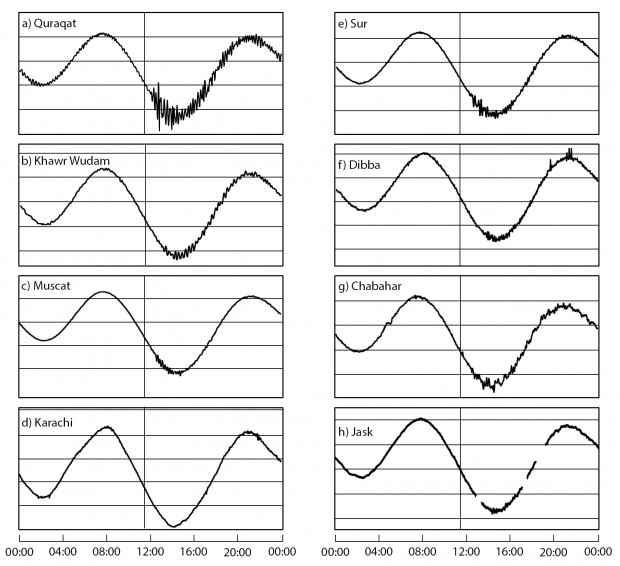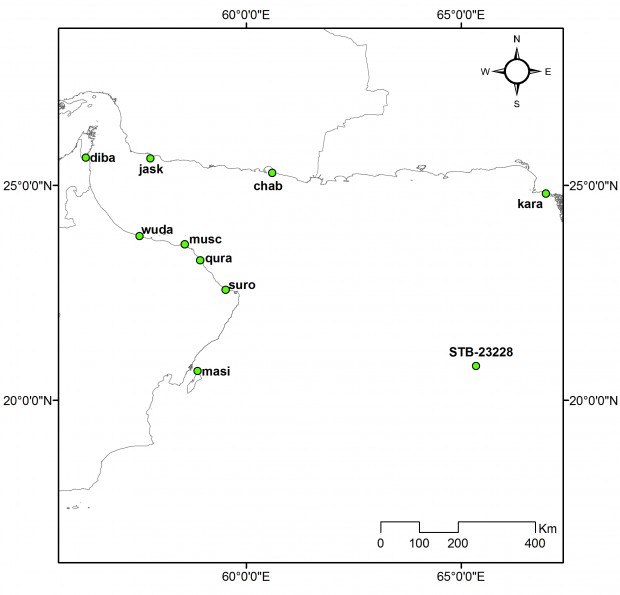On 24 September, 2013, a magnitude 7.7 earthquake occurred in Balochistan, Pakistan. The quake caused intense ground motions and had dramatic consequences – hundreds of people died, and more than 100,000 lost their homes. A secondary effect which caught much attention in the international media was the birth of an island off the Pakistani coast – Zalzala Jazeera or Earthquake Island. Another effect which went almost completely unnoticed was a small tsunami in the Arabian Sea. The tsunami reached wave heights of around 1 m at the Omani coast. In a paper which was recently published in Geology, my colleagues and me document the tsunami effects in Oman. We conclude on a submarine slide off Pakistan as the likely trigger mechanism.
Sea level data from the Northern Indian Ocean show distortions a few hours after the earthquake:
Also, a tsunami buoy in the Indian ocean recorded a disturbance few minutes after the earthquake. From the travel times it became clear that the tsunami buoy whose sensor is placed on the sea floor was affected by the seismic waves, but the sea level stations along the coast recorded a tsunami wave.
What caused the tsunami?
As the earthquake epicentre was located hundreds of kilometers away from the coast, a direct effect of ground displacement could be ruled out. Another observation was that the wave travelled from east to west, but was not registered at tide gauges east of the epicentre’s southward projection. This is a clear directivity effect which can occur due to submarine slides. There are two main regions that have both sufficiently steep slopes and soft sediments that can be mobilized by seismic shaking – the Owen Fracture Zone and the accretionary wedge along the Makran Subduction Zone (MSZ). Tsunami wave velocity is mainly controlled by the water depth, and our calculations showed that the MSZ is much more likely the source area. The birth of the island was very likely related to mud venting and can not have caused the tsunami as this effect was too slow.
Tsunami effects in Oman
In order to document the tsunami effects in Oman we interviewed local fishermen and asked if they observed any strange wave behaviour. The interviews followed the UNESCO-IOC International Tsunami Survey Team (ITST)
protocol. The eyewitnesses reported unusual waves during low tide, a change of water colour during the event, retreating sea before larger waves approached, strong currents they hadn’t observed before, and an unusual large amount of fish they could catch the next morning. The fishermen were so impressed by the spectacle that they recorded several videos:
The information from the interviews, the sea level readings, and photos from the interviews are available as supplementary material in the online data repository 2014313.
What’s so special about this tsunami?
- The distance between the fault that ruptured and the likely landslide source area is quite large, more than 100 km. However, other studies showed that earthquakes of similar size can trigger submarine slides as far away as 250 km from the epicentre. Also, the slope angle off Pakistan is in some parts steep enough to allow mass wasting processes.
- The tsunami was secondary-secondary effect: An earthquake triggered a submarine slide which triggered a tsunami. This kind of cascading effects is currently not included in the tsunami hazard assessments. The fact that the epicentral area is characterized by a quite high seismicity suggests that such phenomena might occur more often than thought.
- The tsunami went almost unnoticed, because it was of low magnitude and no damage was caused (except that two fishing boats collided and their outboars were damaged). Such events can however have severe effects close to the source area.
- For paleoseismologists things are getting more complicated. The MSZ is the only source of megaquakes (M>8.0) in the study area, and it is known to have caused devastating tsunamis in the past – the last one happened in 1945. This subduction zone is seismically relatively quiet in its western part. Paleoseismological studies that could reveal earthquake recurrence intervals, maximum magnitudes etc. have not been conducted and would likely need to be based on turbidite history or paleotsunami deposits – we have now shown that both might be caused by onshore strike-slip events, too.
The earthquake itself is also subject to research, it seems to have a quite weird ripture mechanism. I recommend reading the papers by Avouac et al. (2014), Jolivet et al. (2014), and a very recent one by Barnhart et al. (2014) for more info on the rupture process and the tectonic background.
References
- Avouac, J.-P., Ayoub, F., Wei, S., Ampuero, J.-P., Meng, L., Leprince, S., Jolivet, R., Duputel, Z., & Helmberger, D., 2014. The 2013, Mw 7.7 Balochistan earthquake, energetic strike-slip reactivation of a thrust fault. Earth and Planetary Science Letters, 391, 128–134.
-
Barnhart, W. D., Hayes, G. P., Briggs, R. W., Gold, R. D., & Bilham, R., 2014. Ball-and-socket tectonic rotation during the 2013 Mw7. 7 Balochistan earthquake. Earth and Planetary Science Letters, 403, 210-216.
-
Hoffmann, G., Al-Yahyai, S., Naeem, G., Kociok, M., & Grützner, C., 2014. An Indian Ocean tsunami triggered remotely by an onshore earthquake in Balochistan, Pakistan. Geology, G35756-1. Supplementary material available at ftp://rock.geosociety.org/pub/reposit/2014/2014313.pdf
-
Jolivet, R., Duputel, Z., Riel, B., Simons, M., Rivera, L., Minson, S. E., Zhang, H., Aivazis, M.A.G., Ayoub, F., Leprince, S., Samsonov, S., Motagh, M. & Fielding, E.J., 2014. The 2013 Mw 7.7 Balochistan Earthquake: Seismic Potential of an Accretionary Wedge. Bulletin of the Seismological Society of America, 104(2), 1020-1030.






The 2013 Mw 7.7 Balochistan earthquake in Pakistan: Not so unusual – Centre for the Observation and Modelling of Earthquakes, Volcanoes and Tectonics | 2017-10-27|10:11 (UTC)
[…] 2013, a MW7.7 earthquake struck Balochistan, caused a huge surface offset and triggered a small tsunami in the Arabian […]